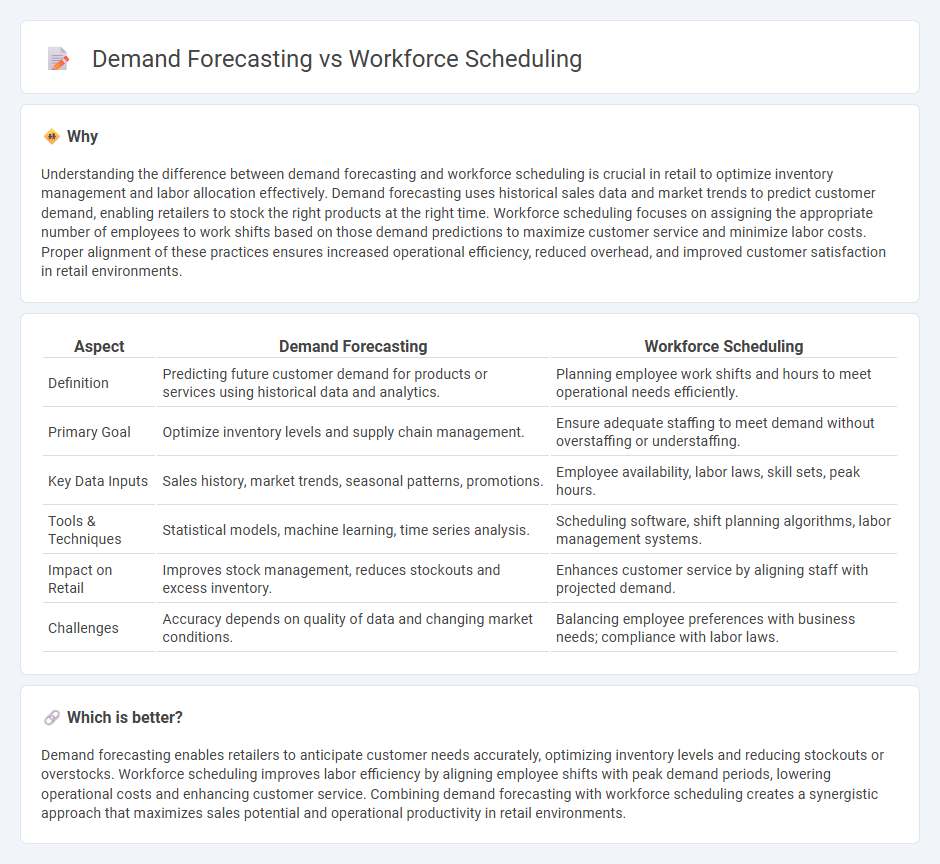
Demand forecasting in retail uses historical sales data and market trends to predict future customer demand, enabling inventory optimization and reducing stockouts. Workforce scheduling allocates staff efficiently based on projected demand, improving customer service and minimizing labor costs. Discover how integrating these strategies boosts retail operational efficiency and profitability.
Why it is important
Understanding the difference between demand forecasting and workforce scheduling is crucial in retail to optimize inventory management and labor allocation effectively. Demand forecasting uses historical sales data and market trends to predict customer demand, enabling retailers to stock the right products at the right time. Workforce scheduling focuses on assigning the appropriate number of employees to work shifts based on those demand predictions to maximize customer service and minimize labor costs. Proper alignment of these practices ensures increased operational efficiency, reduced overhead, and improved customer satisfaction in retail environments.
Comparison Table
| Aspect | Demand Forecasting | Workforce Scheduling |
|---|---|---|
| Definition | Predicting future customer demand for products or services using historical data and analytics. | Planning employee work shifts and hours to meet operational needs efficiently. |
| Primary Goal | Optimize inventory levels and supply chain management. | Ensure adequate staffing to meet demand without overstaffing or understaffing. |
| Key Data Inputs | Sales history, market trends, seasonal patterns, promotions. | Employee availability, labor laws, skill sets, peak hours. |
| Tools & Techniques | Statistical models, machine learning, time series analysis. | Scheduling software, shift planning algorithms, labor management systems. |
| Impact on Retail | Improves stock management, reduces stockouts and excess inventory. | Enhances customer service by aligning staff with projected demand. |
| Challenges | Accuracy depends on quality of data and changing market conditions. | Balancing employee preferences with business needs; compliance with labor laws. |
Which is better?
Demand forecasting enables retailers to anticipate customer needs accurately, optimizing inventory levels and reducing stockouts or overstocks. Workforce scheduling improves labor efficiency by aligning employee shifts with peak demand periods, lowering operational costs and enhancing customer service. Combining demand forecasting with workforce scheduling creates a synergistic approach that maximizes sales potential and operational productivity in retail environments.
Connection
Demand forecasting in retail predicts customer purchase patterns using historical sales data, seasonality, and market trends, enabling accurate inventory management. Workforce scheduling aligns staffing levels with these predicted demand fluctuations, ensuring optimal employee allocation during peak and off-peak hours. This connection reduces labor costs, enhances customer service, and increases operational efficiency.
Key Terms
Labor Allocation
Workforce scheduling optimizes labor allocation by assigning the right number of employees to specific shifts based on real-time availability and skillset, enhancing operational efficiency. Demand forecasting uses historical data and predictive analytics to estimate future labor needs, ensuring resource preparedness and cost reduction. Discover how combining workforce scheduling and demand forecasting can transform your labor management strategy.
Staffing Optimization
Workforce scheduling aligns employee shifts with business needs, ensuring optimal coverage while minimizing labor costs and overtime. Demand forecasting predicts future customer demand using historical data, enabling proactive staffing adjustments to meet service levels efficiently. Explore how integrating these strategies enhances staffing optimization for improved operational performance.
Sales Predictions
Workforce scheduling and demand forecasting are critical components in optimizing sales predictions, with demand forecasting analyzing historical sales data, market trends, and customer behavior to predict future sales volumes. Workforce scheduling aligns staffing levels with these predictions to ensure that the right number of employees are available to meet anticipated demand, thus maximizing operational efficiency and customer satisfaction. Explore how integrating advanced demand forecasting techniques with dynamic workforce scheduling can enhance sales performance and business profitability.
Source and External Links
Workforce scheduling: What it is and how to hone it - Zendesk - Workforce scheduling is the process of optimizing employee schedules to meet organizational demand using strategies like involving the whole team, considering business needs, and leveraging AI-powered workforce management software for better efficiency and personalization.
Oracle Workforce Scheduling - Oracle Workforce Scheduling provides a cloud-based solution that balances business needs, compliance, and employee experience by optimizing schedules through data integration, AI scheduling assistants, and enabling employees to self-manage shifts and preferences.
Employee & Staff Scheduling Software - Workforce Management - Workforce scheduling software allows fast, accurate scheduling with tools like templates, shift swapping, AI scheduling, and compliance enforcement to reduce labor costs, manage availability, and improve workforce efficiency and satisfaction.
 dowidth.com
dowidth.com